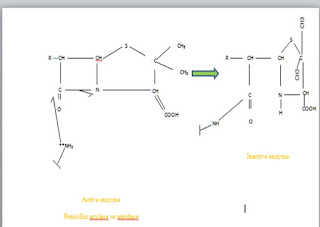Mode of action of penicillin (antibiotics)
Antibiotics function according
to their structures. β-lactam analogues (penicillin) function by exerting their
effects by disrupting the creation of peptidoglycan (core stress bearing
network in bacterial cell wall). The destruction occurs either by blocking the
construction of sub-units of peptidoglycan or by barring their association in
existing network.
As can be seen in the
reaction, four-membrane β-lactam makes amide susceptible to nucleophile acyl
substitution. The action of antibiotics occurs due to their abilities to
acylate the amino group (-NH2) of enzyme that is responsible for
synthesis of bacterial cell wall. The question always arises, if penicillin has
effect on mammalian cells? The answer is no, since mammalian cells are not
enclosed by cell walls. In this process, penicillin changes active enzyme into
inactive enzyme as indicated above thus inhibiting its dangerous action on
cells.
How
does resistance to penicillin occur?
In some situations
resistance to penicillin is experienced. This occurs by bacteria becoming
resistant through mutation and in the process produce β-lactamase which
facilitates the opening of β-lactam. The opened ring is inactive.
For more about action of antibiotics(penicillin), check it here http://bit.ly/1Ke9Zfw
This is a good book for chemistry students, "Chemistry Equations and Answers(Quickstudy:Academic), get it here http://amzn.to/1owPqB6






Comments
Post a Comment